Crucial Portable SSD X6 and X8 2TB Review: QLC for Storage On-the-Go
by Ganesh T S on October 21, 2020 8:00 AM ESTPCMark 10 Storage Bench - Real-World Access Traces
There are a number of storage benchmarks that can subject a device to artificial access traces by varying the mix of reads and writes, the access block sizes, and the queue depth / number of outstanding data requests. We saw results from two popular ones - ATTO, and CrystalDiskMark - in a previous section. More serious benchmarks, however, actually replicate access traces from real-world workloads to determine the suitability of a particular device for a particular workload. Real-world access traces may be used for simulating the behavior of computing activities that are limited by storage performance. Examples include booting an operating system or loading a particular game from the disk.
PCMark 10's storage bench (introduced in v2.1.2153) includes four storage benchmarks that use relevant real-world traces from popular applications and common tasks to fully test the performance of the latest modern drives:
- The Full System Drive Benchmark uses a wide-ranging set of real-world traces from popular applications and common tasks to fully test the performance of the fastest modern drives. It involves a total of 204 GB of write traffic.
- The Quick System Drive Benchmark is a shorter test with a smaller set of less demanding real-world traces. It subjects the device to 23 GB of writes.
- The Data Drive Benchmark is designed to test drives that are used for storing files rather than applications. These typically include NAS drives, USB sticks, memory cards, and other external storage devices. The device is subjected to 15 GB of writes.
- The Drive Performance Consistency Test is a long-running and extremely demanding test with a heavy, continuous load for expert users. In-depth reporting shows how the performance of the drive varies under different conditions. This writes more than 23 TB of data to the drive.
Despite the data drive benchmark appearing most suitable for testing direct-attached storage, we opted to run the full system drive benchmark as part of our evaluation flow. Many of us use portable flash drives as boot drives and storage for Steam games. These types of use-cases are addressed only in the full system drive benchmark.
The Full System Drive Benchmark comprises of 23 different traces. For the purpose of presenting results, we classify them under five different categories:
- Boot: Replay of storage access trace recorded while booting Windows 10
- Creative: Replay of storage access traces recorded during the start up and usage of Adobe applications such as Acrobat, After Effects, Illustrator, Premiere Pro, Lightroom, and Photoshop.
- Office: Replay of storage access traces recorded during the usage of Microsoft Office applications such as Excel and Powerpoint.
- Gaming: Replay of storage access traces recorded during the start up of games such as Battlefield V, Call of Duty Black Ops 4, and Overwatch.
- File Transfers: Replay of storage access traces (Write-Only, Read-Write, and Read-Only) recorded during the transfer of data such as ISOs and photographs.
PCMark 10 also generates an overall score, bandwidth, and average latency number for quick comparison of different drives. The sub-sections in the rest of the page refrence the access traces specified in the PCMark 10 Technical Guide.
Booting Windows 10
The read-write bandwidth recorded for each drive in the boo access trace is presented below.

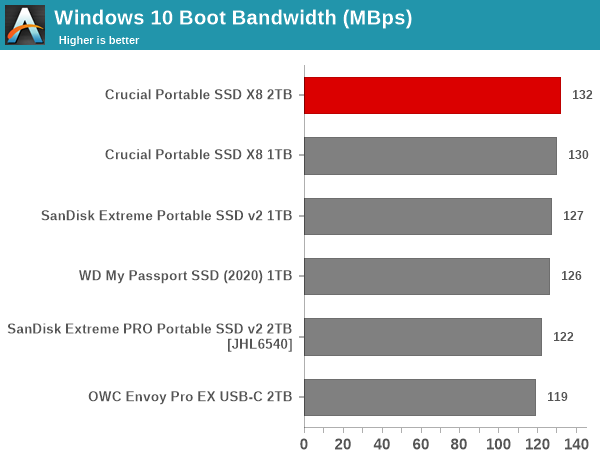
The read-intensive workloads optimization on the X8 helps it to climb to the top of the charts in the tightly clustered NVMe-class graph. On the other hand, the X6 is well below the HP P600 for this workload, but with a narrow lead over the ADATA SC680.
Creative Workloads
The read-write bandwidth recorded for each drive in the sacr, saft, sill, spre, slig, sps, aft, exc, ill, ind, psh, and psl access traces are presented below.

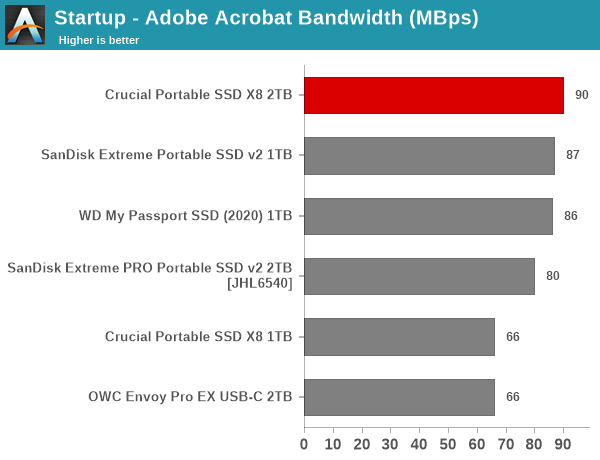
The X6 slots below the HP P600 in the performance charts for creative workloads, but is neck-to-neck with the ADATA SC680. The advantage of the X6 lies in its capacity point - 2TB vs. the 500GB / 1TB of the others in the SATA-class set. The X8, on the other hand, leads the charts for almost all creative workloads. The large amount of SLC cache does help in these types of scenarios, as we shall see in the next section.
Office Workloads
The read-write bandwidth recorded for each drive in the exc and pow access traces are presented below.

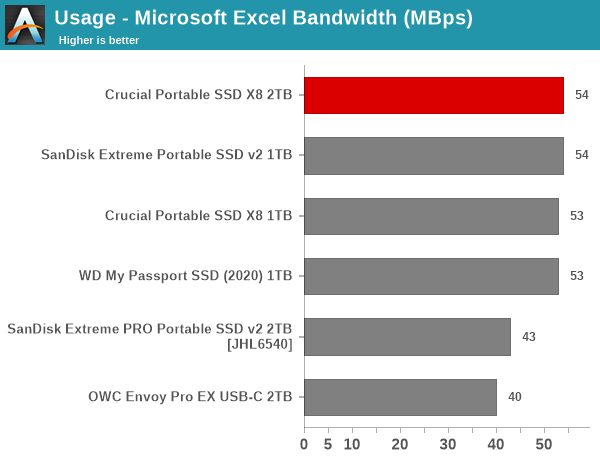
The SATA-class drives follow the same ordering as seen in the creative workloads section. The X8 ties with a bunch of other SSDs in delivering very similar performance numbers for the office workloads.
Gaming Workloads
The read-write bandwidth recorded for each drive in the bf, cod, and ow access traces are presented below.
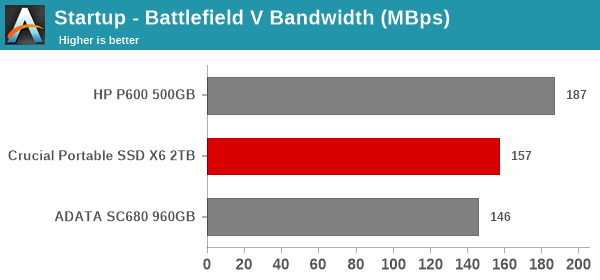
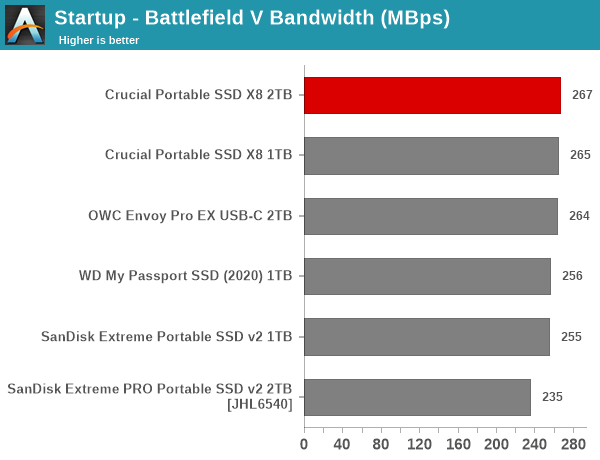
The X6 slots in the middle of the pack, while the X8 leads in the gaming workloads. This augurs well for using the X8 as a portable Steam drive, and for usage with consoles.
Files Transfer Workloads
The read-write bandwidth recorded for each drive in the cp1, cp2, cp3, cps1, cps2, and cps3 access traces are presented below.
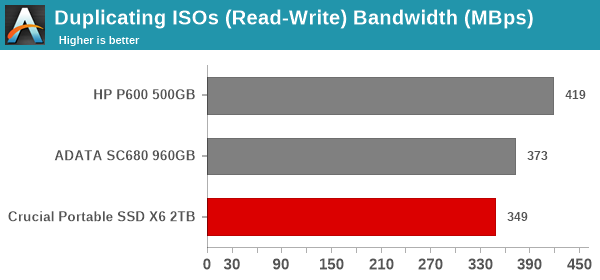
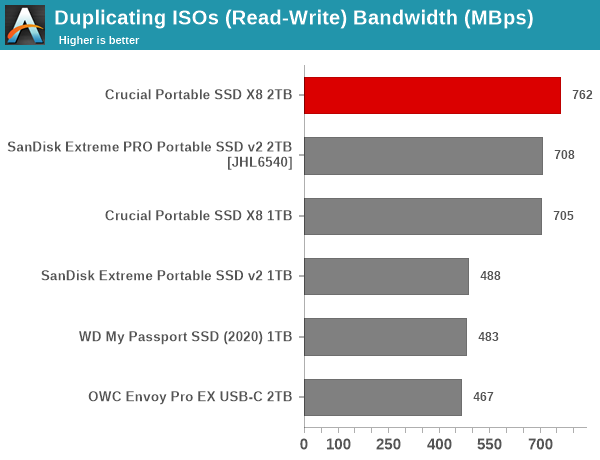
The X6 surprisingly does well in the file transfer workload, though the write-only traces are a problem again. The X8 also acquits itself well, with only the write-only components pushing it to the middle of the pack.
Overall Scores
PCMark 10 reports an overall score based on the observed bandwidth and access times for the full workload set. The score, bandwidth, and average access latency for each of the drives are presented below.
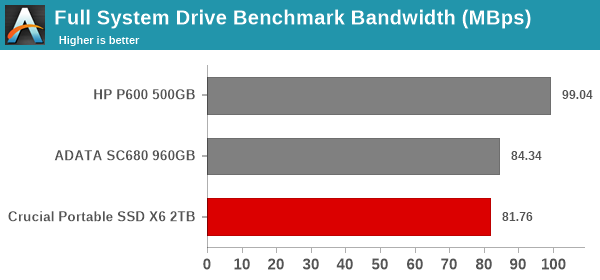
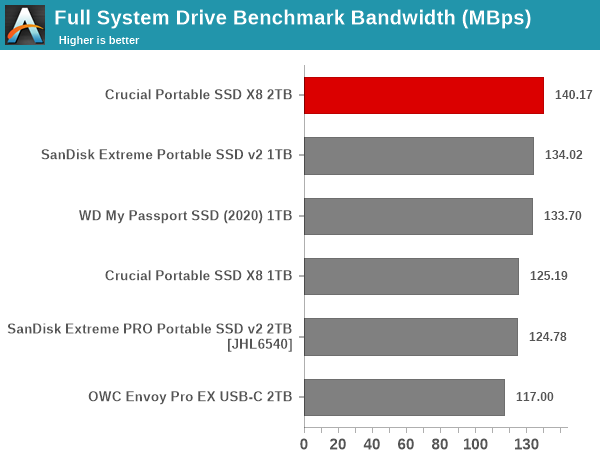
The X6 and X8 are at contrasting places in their respective sets in the overall scores. While the X8 leads by a comfortable margin, the X6 is well below the HP P600. Overall, we see the X8 2TB version being a very competitive performer for traditional consumer workloads. Despite being a QLC drive, how does the X8 manage this feat? We take a look at that in the final section.










22 Comments
View All Comments
luxuryhousebuild - Wednesday, June 23, 2021 - link
At that point they will spend more hours requesting and examining many hard offers from exchanges to assemble a careful and exact financial plan. Given this time venture, it is commonplace for truly solid developers to be made up for their pre-development administrations. You can find an assortment of solutions to this inquiry; https://astorhomesbydesign.com.au/services/ interestingly, you feel great with the pay the manufacturer requests and with how they clarify their part in the pre-development measure for your task.Duncan Macdonald - Thursday, October 22, 2020 - link
This is QLC flash - most QLC will not reach beyond 1000 cycles - some will only reach a few hundred - the rated TBW IS important. Also the write speed on QLC often degrades as the cycle count increases.zepi - Thursday, October 22, 2020 - link
I don't care slightest about write endurance - I have hard time envisioning a use case where this kind of drive is written to death. Even few hundred P/E cycles is a lot for a normal person. If you are not a "normal person" and your workload is heavy, then go and buy something else.However, what I'd be very afraid is the data retention. QLC - drive being unplugged for reasonably long periods of time etc.
It is completely normal for people to take backups, transfer bunch of files etc. and expect them to be readable in half a year from writing after storing the drive in the glove compartment of their car or whatever crazy people do.
Is the data readable after such period? No idea.
AMDSuperFan - Thursday, October 22, 2020 - link
Ganesh - looking at the boxes in your picture they look pretty much banged up. Were these new or used drives that you tested here? I think you are an excellent writer.Oxford Guy - Monday, October 26, 2020 - link
"The emergence of 3D NAND with TLC and QLC has brought down the cost of such drives."You meant:
The emergence of 3D NAND with TLC has brought down the cost of such drives. QLC, meanwhile, is about increasing margin for drive makers and decreasing quality for consumers."
Oxford Guy - Monday, October 26, 2020 - link
"I don't care slightest about write endurance - I have hard time envisioning a use case where this kind of drive is written to death. Even few hundred P/E cycles is a lot for a normal person. If you are not a "normal person" and your workload is heavy, then go and buy something else. However, what I'd be very afraid is the data retention. QLC - drive being unplugged for reasonably long periods of time etc."Drive death in the consumer realm has always been mainly about firmware/controller bugs (or, possibly defective NAND), not the NAND wearing out through use. The most extreme examples I can think of are the Sandforce 2 controllers from OCZ that bricked drives when OCZ switched to 64-bit planar MLC (without telling anyone) and Intel's G2 drive that had a data corruption problem due to bad firmware.
(The Sandforce problem was never solved by a plethora of firmware patches. OCZ pretended that it solved the issue by letting people return the drives but the people who spent the most money (on the highest capacity drives, the 240 GB ones) were not allowed to return them! I have three bricked 240 GB OCZ drives. Two of them are drives OCZ sent when the first ones bricked.)
The differences between things like planar MLC and planar TLC have been about other problems. Planar TLC from Samsung didn't result in drive death (the red herring everyone talks about). Instead, it was voltage drift that caused the data to have to be constantly rewritten as a kludge "solution" to very poor performance. That much more frequent writing slows performance, makes one question the safety of storing the drive powered off for long periods, and can lead to the NAND wearing out I suppose.
Drive death from worn-out NAND has been a red herring for the most part, while other serious drawbacks to increasing the number of voltage states (by adding layers) have been whitewashed. Well, it looks like QLC brings back the drive death from worn-out NAND problem back a bit while having all of the drawbacks of there being so many more voltage states (which increases the problem of drift drastically).
The only things going for it is that it's 3D instead of planar and that capacities have increased which helps to mask the issue for most consumer workloads. Regardless, I consider QLC to be an unsatisfactory solution to a problem consumers didn't face: how to increase margin for the companies selling drives beyond what 3D TLC offers. That's the real driving force being QLC. It is not giving consumers a much better capacity deal for their money. The economy of scale factor, instead, works against consumer value by increasing the price of 3D TLC. Companies use that as an excuse to keep prices of QLC too high. Neat trick, for as long as they can make it last. By winding down TLC capacity, they can do it for as long as they like, so long as no one decides to fight the current and keep high volume TLC production going and reasonable pricing for it (in defiance of the scarcity dynamic).
happythanksgives - Tuesday, November 10, 2020 - link
Clearly, your Thanksgiving menu is critical, yet the event is a long ways past essentially stacking our plates. Thanksgiving is an occasion to exhibit your gratefulness for your partners, family, and all that you have for the duration of regular daily existence https://happythanksgiving2020.com/ . These true Thanksgiving proclamations will assist everyone with recollecting the clarification behind the season. This overview is overflowing with clever words that would make for an exceptional event toast or even as a respectable Thanksgiving engraving through online systems administration media.Henry jones - Monday, November 23, 2020 - link
I guess there is no need to compare 35$ product with the expensive onehttps://ynntechnology.com/product/dry-ice-machine/
iOSEmusapps - Monday, March 15, 2021 - link
It is seen as that getting changed applications is very irksome in iOS, yet iOSEmus simplified this dazzling. It has a whole library of the https://iosemus-app.com/ relative multitude of top notch applications that can fulfill you truly particularly perky. Do whatever it takes not to confide in me? I BET you should endeavor this.mp3pawtv - Monday, July 5, 2021 - link
Mp3Paw Download Free Mp3 Music in High Quality – Can I download free MP3 Music from MP3PAW or how might I will download Free films from MP3paws? https://mp3paw.tv/ Here in this article, you would have the option to gain proficiency with a ton about the mp3 paw download and furthermore how to get to the mp3paw download page to download the decisions of your Mp3 music melodies.